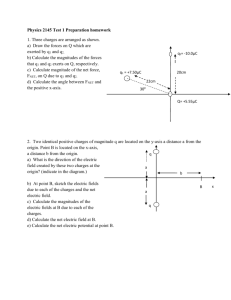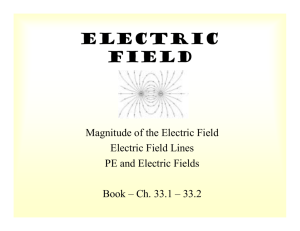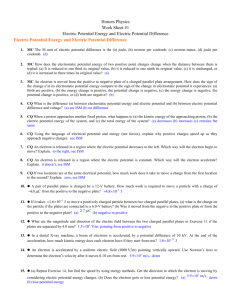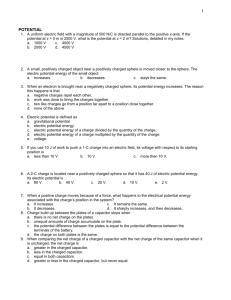Electric Fields
advertisement
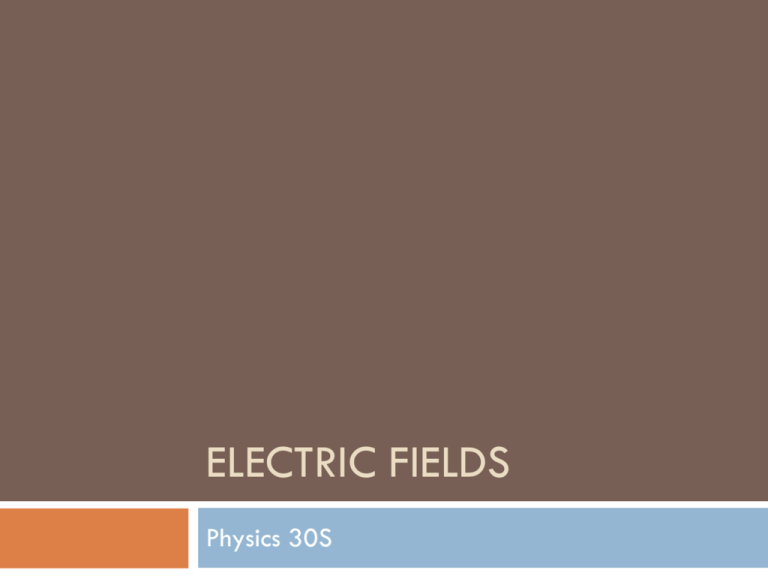
ELECTRIC FIELDS Physics 30S Outcomes S3P-4-14: Define the electric field qualitatively as the region of space around a charge where a positive test charge experiences a force. S3P-4-15: Diagram electric fields using lines of force with respect to a positive test charge. Include: single point charges (positive and negative), near two like charges, near two unlike charges, between a single charge and a charged plate, between two oppositely charged parallel plates S3P-4-16: Define the electric field quantitatively as a force per unit charge (E = F/q) and solve problems using the unit field concept (F = qE). S3P-4-17: Solve problems for the motion of charges between parallel plates where Fnet = Fe + Fg . S3P-4-18: Describe a simplified version of Millikan’s experiment for the determination of the elementary charge (solve for charge when Fe = Fg). S3P-4-19: Define the elementary charge and convert between elementary charges and coulombs. Include: q = Ne Introduction Definition: An electric field is the region of space around a charge where a positive test charge experiences a force Electric field strength is measured by force per unit charge E = Fe/q How Do We Know? http://www.youtube.com/watch?v=7NvKtPq0Hbc Comparing Electric and Gravitational Fields Gravitational Fields Electric Fields Force per unit mass Force per unit charge g = Fg/m E = Fe/q Only attracts Can attract or repel Unit: N/kg Unit: N/C Strength depends on size (mass) of object creating field Strength depends on size (amount of charge) of object creating field Important Physicists Charles-Augustin de Coulomb (1784) Definition of electrostatics (Coulomb’s law) Michael Faraday (1830s) Electromagnetic induction Electric charge per mole of electrons Robert A. Millikan (1923) Millikan’s Oil Drop experiment Units Elementary Charge: 1 e.c. = 1.6 x 10-19 C Coulomb: unit of charge 1 C = 6.25 x 1018 e.c. 1 μC = 1.0x106 C Field: N/C q = n x e.c. (charge is equal to number of electrons x elementary charge) Positive Test Charge Imagine that we could create a small charged particle whose own charge was too small to affect the surrounding electric field Used to map out electric fields Always positive! Rules for Drawing Diagrams • • • Arrows indicate direction that a positive test charge would move in repulsion from positive, attraction to negative Number of lines is proportional to electric field strength Equipotential lines: lines to show locations where the field has equal strength Direction of Electric field at any point is tangent to the field lines Drawing Electric Fields – Single point Charge All lines radiating either towards (negative charge) or away (positive charge) from point Near Like Charges Lines are similar to single point charges, but are altered in the space between charges Lines are pushed away from the midpoint Near Unlike Charges Lines are straight between at the midpoint (pulled tight between the two charges) Electric dipole: two charges of equal magnitude and opposite sign Single Charge and Charged Plate Point charge still radiates, but lines close to the plate are pulled towards/away from the plate Parallel Plates Straight lines between plates Some rounding at the edges Interactive Problems www.explorelearning.com: Charge launcher Coulomb force Homework 1. 2. 3. Draw the electric field for a dipole (one positive, one negative). Draw the electric field for two positive point charges. How would the field diagram change for two negative point charges? Problems Suppose we could drop a positive test charge in an electric field. Draw an arrow in the field diagram to represent the force on the test charge if: a) it is just to the right of a positive point charge b) it is just to the right of a negative point charge c) it is centered between two equal negative point charges d) it is centered between two equal point charges of opposite sign (dipoles) Electric Fields – Intro Questions Example 1 a) A toaster passes -3.00 C of charge through the heating coils. How many electrons move through the coils? b) How many electrons would it take to make up a charge of –12.4 μC? a) q = -3.00 C 1 electron has a charge of -1.6 x 10-19 C 1.88 x 1019 electrons b) q = -12.4 x 10-6 C 1 electron has a charge of -1.6 x 10-19 C 7.75 x 1013 electrons Example 2 A test charge of +5.00 C is placed a distance of 2.00 m to the right of the point charge +q. The strength of the electric field produced by this charge is +10.0 N/C. What is the electric force on the test charge? What is the direction of this force? E = Fe/q Fe = Eq = (+10.0 N/C)(+5.00 C) Fe = +50.0 N Direction: Positive force indicates repulsion. Test charge will move to the right. Example 3 A test charge of +5.00 C is placed a distance of 2.00 m to the right of the point charge -q. The strength of the electric field produced by this charge is -10.0 N/C. What is the electric force on the test charge? What is the direction of this force? E = Fe/q Fe = Eq = (-10.0 N/C)(+5.00 C) Fe = -50.0 N Direction: Negative force indicates attraction. Test charge will move to the left. Example 1b (Optional Extra) a) How many electrons would it take to make up a charge of –1.28 x 10-18 C? b) A lightning bolt passes -25.0 C of charge in a strike. How many electrons are in the strike? a) q = -1.28 x 10-18 C 1 electron has a charge of -1.6 x 10-19 C 8.0 electrons b) q = -25.0 C 1 electron has a charge of -1.6 x 10-19 C 1.6 x 1020 electrons Example 2b (Optional Extra) A test charge of +3.00 C is placed a distance of 5.00 m to the right of the point charge +q. The strength of the electric field produced by the point charge is +8.00 N/C. What is the electric force on the test charge? What is the direction of this force? E = Fe/q Fe = qE = (+3.00 C) (+8.00 N/C) Fe = +24.0 N Direction: Positive force indicates repulsion. Test charge will move to the right. Example 3b (Optional Extra) A test charge of +3.00 C is placed a distance of 5.00 m to the right of the point charge -q. The strength of the electric field produced by the point charge is -8.00 N/C. What is the electric force on the test charge? What is the direction of this force? E = Fe/q Fe = qE = (+3.00 C) (-8.0 N/C) Fe = -24.0 N Direction: Negative force indicates attraction. Test charge will move to the left. Example 4 A positive charge on the left of a test charge creates an electric field of 10.0 N/C. Another positive charge to the left of a test charge creates an electric field of 15. 0 N/C. a) What is the total electric field acting on the test charge? b) If a charge of 2.0 C is placed in between the two charges, what is force acting on the charge? Example 4 - Solution E1 = 10.0 N/C, positive test charge will move to the right E2 = 15.0 N/C, positive test charge will move to the right Enet = 25.0 N/C, positive test charge will move to the right Example 4 - Solution Fnet = F1 + F2 Fnet = qE1 + qE2 Fnet = (2.00 C) (10.0 N/C) - (2.00 C) (15.0 N/C) Fnet = -10.0 N Fnet is to the left Homework 1. Intro to Electric Fields Homework Handout Finish #3-6 # 1-2 Questions? Handout #1-6 Adding Electric Fields Electric Fields must be added using vector addition. Draw a diagram to represent the direction of the fields. Use Pythagoras to find the magnitude of the resultant field, and then use inverse tangent and your diagram to determine the direction. Remember, the direction of the field is the direction of the force that a positive test charge would experience! Adding Electric Fields Handout – Question 3 The electric field due to Q1 has a magnitude of 220 N/C at point W. The electric field due to Q2 at point W has a magnitude of 420 N/C. What is the net electric field (magnitude & direction) at point W? What is the net electric force (magnitude & direction) experienced by an electron if placed at point W? W Q2 Q 1 E = 470 N/C @ 28° S of W; F = 7.6 × 10-17 N @ 28° N of E One Last Extra Example – Electric Fields Handout 2 A negative charge creates a field of magnitude 100 N/C at x. A positive charge creates a field of magnitude 75 N/C at x. a) Find the magnitude and direction of the net electric field at X. b) If an electron is located at x, find the magnitude and direction of the net force acting on the electron. E = 125 N/C, E 37°S F = 2.0 x 10-17 N, W37°N Homework Adding Electric Fields Handout #1, 2, 4 Millikan’s Oil Drop Experiment Elementary charge: there is a fundamental unit of charge. All quantities of charge must be a multiple of this fundamental unit. Make Fe equal to Fg Charge floats Allowed Millikan to solve for charge The Apparatus Robert A. Millikan Nobel Prize in Physics (1923) Cartoon of Millikan’s Experiment: http://www.youtube.com/watch?v=91E6KvCvRf0&NR=1 Motion of Charges between Parallel Plates Fnet = Fg+ Fe If Fnet is zero, then Fg and Fe must be equal! Millikan Examples – Question 1 A negatively charged droplet of oil (m=2.0 x 10-5 kg) is placed between two oppositely charged plates (upper plate is positive). The oil drop is balanced when the electric field is adjusted to 4.2 x10-7 N/C. a) What is the charge on the oil drop? b) How many elementary charges are on the oil drop? a) q = -470 C b) There are 2.9 x 1021 electrons on the oil drop Question 2 An oil drop, whose mass is found to be 4.95 x 10-15 kg, is balanced between two large horizontal plates with the upper plate positive. The electric field strength between the plates is E = 5.10 x 104 N/C. a. What is the charge on the oil drop, both in coulombs and in elementary charges? b. Is it an excess or deficit of electrons? Question 2 Solution a) q = -9.51 x 10-19 C = 5.94 e.c. b) The electrical force on the oil drop must be upwards in order to counteract gravity. Thus, the drop is being attracted by the upper plate and repelled by the lower plate. Since the upper plate is positive, the oil drop must be negative. There is an excess of electrons! (≈ 6 electrons) Question 3 Suppose Millikan was able to isolate an electron so that it balances between parallel plates. What is the magnitude and direction of the electric field? (mass of an electron is 9.11 x 10-31 kg and charge of an electron is -1.6 x 10-19 C). What is the magnitude and direction of the electric force acting on the electron? E = 5.6 x 10-11 N/C, down F = 8.9 x 10-30 N, up Homework Millikan: Electric Fields and Big Four Worksheet #8 van de Graaff Generator A van de Graaff is an apparatus able to hold a charge on the outer ball. Any excess charge collects on the outer rim of the ball. A van de Graaff in Action http://www.youtube.com/watch?v=fTHOPe7mGIk As negative charge collects on the ball, it is transferred to the confetti paper. The paper pieces acquire negative charge and repel each other, causing the explosion seen in the video. Question 1 A charged paper confetti of mass 1.0 x 10-7 kg is hovering above a field of -70. N/C. What is the charge on the confetti? How many electrons make up this charge? q = -1.4 X 10-8 C There are 8.8 x 1010 electrons in the charge. Question 2 A pie plate of mass 0.005 kg carries a charge of 9.80 X 10-4 C. The plate hovering above the ball of the van de Graaff. What is magnitude and direction of the electric field of the van de Graaff? What is the magnitude and direction of the force acting on the pie plate? E = 50.0 N/C, down F = 0.0490 N, up Question 3 - Challenge Suppose you have been abducted by mad scientists and you have no idea where you are. You are being forced to solve parallel plates questions by applying Fnet = Fe + Fg. Suppose an electron (mass is 9.11 x 10-31 kg and charge is -1.6 x 10-19 C) is hovering in a electric field of magnitude 1.48 x 1010 N/C. Are you still on Earth? Why or why not? Bonus: What planet could you be on? No. You are not on Earth because g ≠9.8 m/s2. Since g = 26 m/s2, you could be on Jupiter. Homework van de Graaff: Electric Fields and Big Four Worksheet #6 Using the Big Four Just like in the other units, we can apply our knowledge of the Big Four equations to Electric Fields! Example 1 A test charge is placed between charged plates. The electric field strength is 10.0 N/C. The test charge has a charge of q = +2.00 C and a mass of 4.00 x 10-4 kg. Assume the positive plate is on top. a. Find the acceleration of the particle. b. If the particle is initially at rest, what is the object’s velocity after 6.0 ms? a) 5.0 x 104 m/s2 b) Vf = 3.0 x 102 m/s Example 2 A charge, q1 = -5.00 C, is placed in an electric field between two charged plates (upper plate is positive). The electric field strength is E = 4.00 N/C. The mass of the charged particle is m = 2.00 x 10-4 kg. a. Determine the magnitude and direction of the acceleration of the charged particle. b. If the particle is initially at rest, what will the displacement be after 8.00 ms? a) a = 1.00 x 105 m/s2 , up b) d = 3.20 m Example 3 A charge, q1 = 600.0 µC, is placed in an electric field between two charged plates (upper plate is positive). The charge accelerates until it crashes into the negative plate, located 1.4 mm away. The electric field strength is E = 800.0 N/C. The mass of the charged particle is m = 2.00 x 10-6 kg. a. Determine the acceleration of the charged particle. b. If the particle is initially at rest, what will the final velocity be when it contacts the plate? a) a = 2.4 x 105 m/s2 b) v = 26 m/s Homework Electric Fields and the Big Four (Uniform Fields) # 1-5, 7 The Plan Day 1: Intro to electric fields and diagrams Tesla coil, diagrams Day 2: Field Problems Review & explorelearning.com Class questions and homework #1-2 Day 3: More Field Problems / Work Class Review questions from last day Make explicit what negatives mean (negative handout) Homework: 3-6 Day 4: Adding Electric Fields with Vectors Day 5: Millikan’s oil drop and questions Day 6: Van de Graaff problems Day 7: Big Four Day 8: In-Class Assignment (optional) Day 9: Review Day 10: Test



